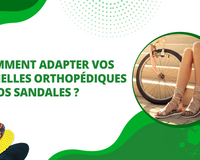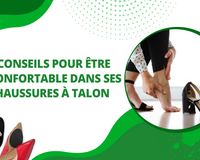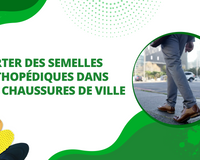
If you've ever heard of a heel spur, you may know how painful and disabling it can be when associated with a plantar fasciitis. A heel spur, known as a bony growth that forms on the heel, can be caused by repetitive movements or excessive pressure.
However, its symptoms are very troublesome, so it's vital to start treating a heel spur as soon as you're aware of it. Fortunately, there are a number of natural solutions for treating heel spurs, including footbaths, foot stretching, cold therapy and acupuncture, all of which can soothe patients suffering from this pathology.
However, these treatments are generally more effective when used in conjunction with medical devices such as adapted footwear, medication or orthotics.
What is a heel spur?

If you're a runner or a top-level athlete, you've probably heard of heel spurs. But what exactly is a heel spur, and how can you get rid of it? A heel spur is in fact a very common pathology, generally caused by inflammation of the heel. plantar fascia which in turn can cause a bony outgrowth to form on the heel, resulting in intense pain.
Heel spur: common causes

There are many causes of heel spurs, the most common of which are :
- Overweight (obesity)
- Plantar morphology (flat foot)
- Use of inappropriate or uncomfortable footwear
- Overuse of heel tendons and muscles, particularly due to repetitive movements or excessive exercise.
How can a heel spur be healed quickly?

Being a bony spike that develops under the heel of the foot, a heel spur can cause intense pain in the plantar area. Fortunately, there are a number of ways to relieve the pain caused by this plantar pathology.
But then, can you walk with a heel spur? The answer is yes, you can walk with a heel spur. To walk with a heel spur and reduce foot pain, it's very important to take into account certain practices, such as wearing the right heel spur shoes.
In addition, to relieve heel spurs, you can :
- Use low-heeled shoes to reduce pressure on the heel.
- Stretch the foot regularly.
- Use custom-made shoes adapted to your foot morphology.
- Avoid any physical activity that puts excessive pressure on the heel of your foot.
- Rest your foot immediately after a long walk and apply ice.
How can I prevent heel spur pain?
To relieve the pain caused by this condition, it's important to know how to treat heel spurs quickly. So there are several ways to prevent the pain caused by a heel spur once the first symptoms have appeared. For example, you can:
- Wear low-heeled heel spur shoes that are comfortable and fit your feet well.
- Avoid repetitive movements that can stress tendons and heel muscles, such as running, dancing, etc.
- Avoid walking or exercising on uneven, hard surfaces.
- Stretch before and after exercise.
- Adopt a healthy lifestyle, with a well-balanced diet rich in vitamin B12 and omega-3.
How long does a heel spur last?
For those who don't know yet, treating a heel spur - which is, by the way, a fairly painful plantar pathology - can often seem like an obstacle course, and generally requires a combination of solutions to find relief from the pain it causes.
However, it should be borne in mind that healing a heel spur takes time, and generally takes between 1 and 3 months to treat this foot condition, which can recur.
Healing a heel spur: how do I go about it?

If you suffer from the notorious heel spur, you need to know that it's not a pain to be taken lightly. That's why there are several types of treatment available for heel spurs that can also soothe the pain and help reduce inflammation, including natural treatments (cold, stretching, footbaths, etc.), and more traditional treatments (massage, massage, etc.), acupuncture, etc.) or medical treatments (custom-made orthopedic insoles, shockwave treatment, shoes, heel pads, etc.).
How to treat heel spurs naturally?

Cold / ice compresses
To reduce the pain and inflammation caused by heel spurs, you can use ice compresses or apply an ice pack directly to your heel.
Heel spur grandmother's remedy
Footbaths can also help heal heel spurs by reducing tissue inflammation. The trick is quite simple, and all you need to do is :
- Place your feet in a basin of warm water for fifteen to twenty minutes.
- Add essential oils such as juniper, peppermint or lavender for added effectiveness.
Stretching exercises
Stretching your heel muscles, tendons and ligaments can help relieve pain. To do this, you need to practice them regularly, taking the time to do them properly. This will help reduce the tension in the fascia, and consequently its inflammation.
Acupuncture: the ideal way to relieve heel spurs
Acupuncture can help relieve pain. The needles used in acupuncture cause very little pain and are very fine. Studies have shown that acupuncture is effective in relieving heel spur pain when combined with other natural or medical treatments.
How to treat heel spurs with homeopathy?
To find out how to treat heel spur with homeopathy, we recommend the use of Hekla Lava 15 CH. Treatment involves applying 3 granules morning and evening until symptoms disappear.
Medical treatments for heel spurs

Use of orthopedic insoles / heel spur insoles
The use of orthopedic insoles can help reduce the pain and inflammation of the plantar fascia caused by heel spurs. In addition insoles for heel spurs also provide support for the heel and arch of the foot, to help correct footing.
Using anti-shock heel pads
These devices can also help reduce pain and tissue inflammation caused by heel spurs, as their silicone or gel materials absorb vibrations during walking.
Use of suitable footwear
The right footwear for your foot type can help relieve the pain and inflammation caused by heel spurs. To achieve this, choose shoes with a flexible sole and a high level of cushioning.
Heel spur treatment shockwave
As a non-invasive treatment, shockwaves can be used to relieve pain of heel spurs. In foot disorders, shockwaves aim to kick-start the natural healing process, and this type of treatment is performed by a physiotherapist.
Medication to relieve heel spurs
If the above methods fail to relieve the pain and inflammation associated with heel spurs, your doctor may prescribe corticosteroids or anti-inflammatory drugs.
These drugs are usually administered in the form of creams or tablets, and can help reduce pain and inflammation.
How to dissolve a heel spur surgically?

However, if the above non-invasive treatments are not effective in relieving the pain caused by inflammation of the fascia, your GP may recommend surgery. This procedure will directly resorb the spur of the calcaneus bone. There are 2 possible solutions:
- The first surgical solution involves lengthening the Achilles heel tendon.
- The second is to perform surgery directly on the plantar fascia.
Conclusion
Heel spurs are extremely painful and can make walking and wearing shoes difficult. Fortunately, there are simple ways of treating heel spurs. But if symptoms persist, it's advisable to consult a doctor or podiatrist for more specific treatments.









